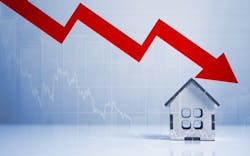How Far Will Home Prices Fall This Year?—One Housing Expert Weighs In
Average rates for a 30-year fixed-rate mortgage dipped to 6.95% during the first week of November, but for the week ending Nov. 10, that figure had climbed back to 7.08%, Realtor.com reports. Unless inflation cools significantly in the weeks ahead, more rate hikes from the Federal Reserve are expected, though climbing borrowing costs are causing a much-needed slowdown in home price gains.
The median list price for a typical U.S. home peaked at $450,000 in June, and has since fallen in October to $425,000. As holiday seasonality continues to slow home sales, some experts predict that median listing price growth could post only single-digit gains by the end of the year.
“The typical asking price will near but not likely slip below $400,000 again this year,” explains Hale. “The housing market is resetting, but in a slow fashion.”
And while home prices have been decreasing month to month, they’re still higher than last year. For the week ending Nov. 10, home prices rose by 11.7% compared with the same week a year earlier.
That’s the 45th week straight of double-digit growth, although the pace has at least been ebbing, which means that home shoppers might not have to contend with double-digit price hikes much longer.
